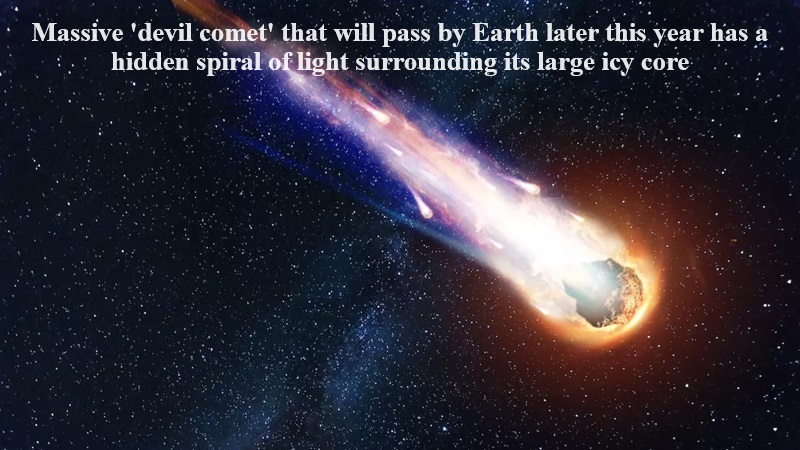
New visuals have unveiled an intriguing feature of the colossal “devil comet” set to approach Earth later this year: a concealed spiral of light encircling its expansive icy nucleus. Employing photo editing techniques, scientists detected this luminous green swirl, which would have likely remained unnoticed otherwise.
The comet 12P/Pons-Brooks completes an orbit around the sun every 71 years in a highly elliptical trajectory, primarily composed of ice and rock. As reported by Spaceweather.com, it is currently journeying towards the sun.
Similar to most comets, 12P possesses a core comprising ice, gas, and dust, encased by a frozen shell or nucleus. This nucleus is further enveloped by an icy dust cloud termed a coma, gradually escaping from the comet’s interior. However, 12P stands out as a cryovolcanic comet, frequently erupting as solar radiation triggers extensive fissures within its nucleus. These eruptions propel highly pressurized icy material, referred to as cryomagma, into space, significantly expanding its coma and enhancing its brightness temporarily.
In July of the previous year, astronomers were captivated when 12P erupted for the first time in nearly seven decades, subsequently continuing to erupt at a relatively frequent pace. Initially, the comet’s expanded coma displayed an irregular shape due to a notch in the nucleus obstructing cryomagma outflow, resulting in a demonic horn-like appearance and earning it the ominous moniker. However, recent eruptions have seemingly erased these horns.
As 12P edges closer to the sun, its coma becomes more pronounced, featuring a green hue attributed to heightened dicarbon levels. Additionally, a substantial tail composed of dust and ice has formed, expelled from the coma by the solar wind, enhancing the comet’s visual appeal for astrophotographers.
Astrophotographer Jan Erik Vallestad captured striking images of 12P and its extended tail on March 9 from Norway, utilizing specialized software to emphasize the evolving intensity of the coma’s light, unveiling a previously undiscovered spiral within the coma. Likewise, images by Juris Se??ikovs, an astrophotographer from Latvia, employing Vallestad’s imaging technique, showcased the spiral structure.
The spiral formation likely arises from small geysers on 12P’s surface expelling streams of cryomagma, subsequently twisted into the visible swirls as the comet rotates.

Post Your Comments